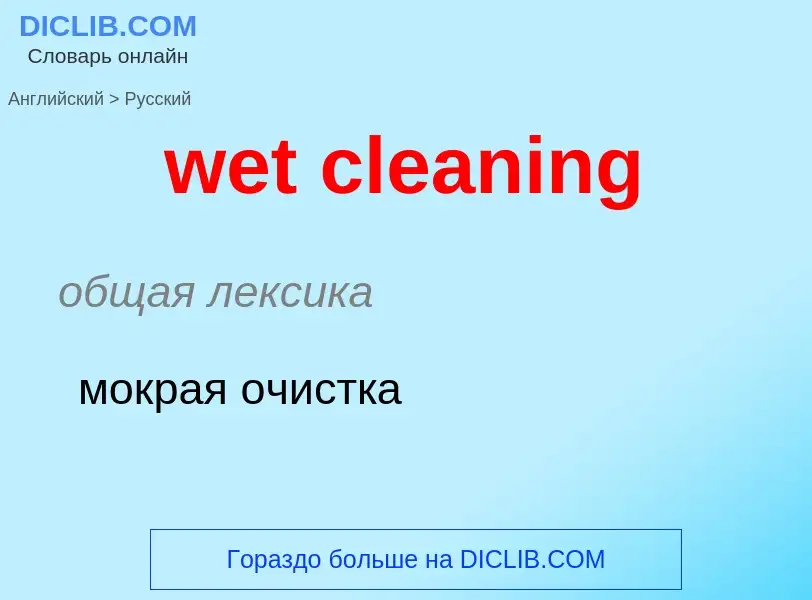Перевод и анализ слов искусственным интеллектом ChatGPT
На этой странице Вы можете получить подробный анализ слова или словосочетания, произведенный с помощью лучшей на сегодняшний день технологии искусственного интеллекта:
- как употребляется слово
- частота употребления
- используется оно чаще в устной или письменной речи
- варианты перевода слова
- примеры употребления (несколько фраз с переводом)
- этимология
wet cleaning - перевод на русский
общая лексика
мокрая очистка
общая лексика
детергент
моющее средство
смывочный раствор
[drai'kli:niŋ]
существительное
общая лексика
химическая чистка
химчистка (процесс)
['kli:niŋ]
общая лексика
чистка
уборка
очистка
фильтрация
флотация
чистящий
очистительный
добыча полезных ископаемых
обогащение
выборка пустой породы
металлургия
зачистка (отливок)
прилагательное
общая лексика
очищающий
очистительный
существительное
['kli:niŋ]
общая лексика
(часто cleaning up)
чистка
уборка
очистка
чистка, уборка
сельское хозяйство
сортирование
отсортировка (семян)
прореживание
«проверка» (всходов)
добыча полезных ископаемых
обогащение
техника
осветление
Определение
Википедия
Wet cleaning refers to methods of professional cleaning that, in contrast to traditional dry cleaning, avoids the use of chemical solvents, the most common of which is tetrachloroethylene (commonly called perchloroethylene or "perc"). Environmental groups and the United States Environmental Protection Agency (EPA) have indicated that such alternative "wet cleaning" methods are better for the environment than perc, and proponents of wet cleaning state that these methods can be used without shrinking or otherwise damaging garments that typically require dry cleaning.
Computer-controlled wet cleaning machines, special dryers, safe detergents and non-toxic spot removers make wet cleaning an environmentally sound method. Wet cleaning machines have controls that allow them to safely and efficiently clean a wide variety of garments in water. Detergents and spot removers are made of ingredients that are safer for workers and the environment, yet are as safe and effective at removing soils, stains and odors as dry cleaning solvents. Equipment, detergents and skill all contribute to successful wet cleaning.
According to the US EPA, wet cleaning is the most environmentally sensitive professional method of garment cleaning. It does not use hazardous chemicals, it does not generate hazardous waste, nor does the process create air pollution, and it reduces the potential for water and soil contamination. The specialized detergents and conditioner used in the wet clean process are milder than home laundry products. All of the products are disposed of down the drain and are easily handled by the local waste water treatment facility. For professional cleaners, wet-cleaning is argued to offer several advantages, such as lowered costs for start-up capital, supplies, equipment and hazardous waste disposal, as well as less reliance on skilled labor.
From American Dry Cleaner: "74.7% of dry cleaners use wet cleaning when cleaning casual clothing and sportswear; specialty items, like draperies and gowns (42.3%); “business casual” or softly tailored clothing (38%); restoration work (25.4%); and tailored workwear (16.9%). Some clothing manufacturers may mislabel their clothing "Dry Clean Only", even though there is no "reasonable basis" for making the claim that the garment will be harmed if it is not dry cleaned.




![art conservation]] art conservation]]](https://commons.wikimedia.org/wiki/Special:FilePath/Conservation at the Church of Suceviţa.jpg?width=200)
![A shop assistant washing a shop window in [[Jyväskylä]], [[Finland]] in the 1960s. A shop assistant washing a shop window in [[Jyväskylä]], [[Finland]] in the 1960s.](https://commons.wikimedia.org/wiki/Special:FilePath/Kulutusosuuskuntien Keskusliiton kokoelma D1974 7644 (30878351716).jpg?width=200)
![[[Laundry]] in a river [[Laundry]] in a river](https://commons.wikimedia.org/wiki/Special:FilePath/Laundry in the river.jpg?width=200)

 3.jpg?width=200)





